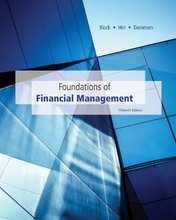Foundations of Financial Management Block 15th Edition Test Bank

Product details:
- ISBN-10 : 1259194078
- ISBN-13 : 978-1259194078
- Author: Geoffrey A. Hirt
The integrated solutions for Block’s Foundations of Financial Management have been specifically designed to help improve student performance, meaning that students are prepared for and engaged in class, and they can successfully solve problems and analyze the results. McGraw-Hill’s adaptive learning component, LearnSmart, provides assignable modules that help students master chapter core concepts and come to class more prepared.
People also search:
Foundations of Financial Management
Foundations of Financial Management Block Hirt Danielsen
Foundations of Financial Management Block Hirt Danielsen 15th
Foundations of Financial Management Block Hirt Danielsen 15th Test Bank
Foundations of Financial Management Block 15th Edition Test Bank
Description:
Chapter 01
The Goals and Activities of Financial Management
True / False Questions
1. As finance emerged as a new field, much emphasis was placed on mergers and acquisitions.
True False
2. Inflation is assumed to be a temporary problem that does not affect financial decisions.
True False
3. Financial capital is composed of long-term plant and equipment, as well as other tangible investments.
True False
4. Real capital is composed of long-term plant and equipment.
True False
5. During the 1930s, financial practice revolved around such topics as the preservation of capital, maintenance of liquidity, the reorganization of financially troubled corporations, and bankruptcy.
True False
6. In the mid 1950s, finance began to change to a more analytical, decision-oriented approach.
True False
7. Recently, the emphasis of financial management has been on the relationship between risk and return.
True False
8. The first Nobel Prizes given to finance professors were for their contributions to capital structure theory and portfolio theories of risk and return.
True False
9. “Credit default swaps” are one of several tools that Congress and the President of the United States have jointly developed to ease the financial crisis that began in 2008.
True False
10. The Internet impacts e-commerce by creating a mechanism for improved communications between a business, its customers, and its suppliers.
True False
11. The Internet has accounted for an acceleration of productivity for “old economy” firms.
True False
12. The Internet is responsible for many new business models.
True False
13. Businesses will increasingly rely on B2B Internet applications to speed up the cash flows through their firms.
True False
14. The Dodd-Frank Act contains the Volcker Rule, which encourages financial institutions to allow for more speculative investments for average investors.
True False
15. The Dodd-Frank Act’s oversight allowing regulation of banking fees and available products has been considered as not being in the best interests of a free market.
True False
16. Sole proprietorship means single-person ownership and offers the advantages of simplicity of decision making and low organizational and operating costs.
True False
17. Profits of sole proprietorships are taxed at corporate tax rates.
True False
18. There is unlimited liability in a general partnership.
True False
19. The most common partnership arrangement carries limited liability to the partners.
True False
20. A limited partnership limits the profits partners may receive.
True False
21. In terms of revenues and profits, the corporation is by far the most important form of business organization in the United States.
True False
22. As noted in Finance in Action, initial public offerings have now increased because long-term results are favored by shareholders and institutional investors.
True False
23. Dividends paid to corporate stockholders have already been taxed once as corporate income.
True False
24. One advantage of the corporate form of organization is that income received by stockholders is not taxable since the corporation already paid taxes on the income distributed.
True False
25. A corporation must have more than 75 stockholders to qualify for Subchapter S designation.
True False
26. Profits of a Subchapter S corporation are taxed at corporate tax rates.
True False
27. The formation of a Subchapter S corporation is a way to circumvent the double taxation of a small corporation.
True False
28. Corporate governance issues have become less important to the financial community during the first decade of the new millennium.
True False
29. The issues of corporate governance are really agency problems.
True False
30. Agency theory examines the relationship between companies and their customers.
True False
31. Institutional investors have had increasing influence over corporations with their ability to vote with large blocks of stock and replace poorly performing boards of directors.
True False
32. Agency theory assumes that corporate managers act to increase the wealth of corporate shareholders.
True False
33. The Sarbanes-Oxley Act reduced agency conflicts by giving corporate managers greater flexibility to select their preferred candidates to the board of directors.
True False
34. A major focus of the Sarbanes-Oxley Act is to make sure that publicly traded companies accurately present their assets, liabilities, and income in their financial statements.
True False
35. The Sarbanes-Oxley Act is primarily intended to increase public scrutiny of private companies that had previously been exempt from many public disclosure requirements.
True False
36. Timing is not a particularly important consideration in financial decisions.
True False
37. The higher the profit of a firm, the higher the value the firm is assured of receiving in the market.
True False
38. There are some serious problems with the financial goal of maximizing the earnings of the firm.
True False
39. Maximizing the earnings of the firm is the goal of financial management.
True False
40. Because socially desirable goals can impede profitability in many instances, managers should not try to operate under the assumption of wealth maximization.
True False
41. Insider trading involves the use of information not available to the general public to make profits from trading in a company’s stock.
True False
42. Social responsibility and profit maximization are synonymous.
True False
43. Financial markets exist as a vast global network of individuals and financial institutions that may be lenders, borrowers, or owners of public companies worldwide.
True False
44. Money markets refer to those markets dealing with short-term securities having a life of one year or less.
True False
45. Money markets refer to markets where excess corporate cash is exchanged for foreign currencies that can earn a higher return than domestic money.
True False
46. Capital markets refer to those markets dealing with short-term securities that have a life of one year or less.
True False
47. The primary market includes the sale of securities by way of initial public offerings.
True False
48. High-quality initial public offerings are usually sold in a primary market, such as the New York Stock Exchange. However, low-quality stocks must usually be sold in secondary markets, such as NASDAQ.
True False
49. Although NASDAQ is a secondary market, some of the firms traded there, such as Microsoft, are large enough to move to the primary market if they so desire.
True False
50. The secondary market characteristically has had stable prices over the past 20 years.
True False
51. In the United States, stocks sold on either the New York Stock Exchange or NASDAQ are considered sold in the primary market.
True False
52. New issues are sold in the secondary market.
True False
53. Existing securities are traded in the secondary market.
True False
54. Many companies have cross-listed their stock on multiple international stock exchanges and more than several hundred foreign companies have listed their shares on the New York Stock Exchange.
True False
55. Higher return always induces stockholders to invest in a company.
True False
56. Social responsibility is an expense and thus should be avoided by financial managers because it will lead to loss of income.
True False
57. Financial management requires both short-term activities as well as long-term planning such as raising funds.
True False
58. One of the primary disadvantages of maximizing shareholder value is that it only provides a short-term perspective.
True False
59. If a company has a written code of ethics, they will generally avoid ethical problems.
True False
60. Risk management will be an important factor over the next decade.
True False
Multiple Choice Questions
61. Which of the following did not contribute to the financial crisis?
A. The use of market-to-market accounting standards
B. Solid credit ratings from the ratings agencies
C. The extension of credit to high-risk borrowers
D. The merger of JPMorgan Chase and Bear Stearns
E. All of the options contributed to the financial crisis.
62. Credit swaps are
A. an insurance product designed to protect financial institutions from customers who default on their loans.
B. securities with a maturity of less than one year.
C. the result of a leveling off or slowing down of price increases.
D. market trades in previously issued securities.
63. What is the primary goal of financial management?
A. Increased earnings
B. Maximizing cash flow
C. Maximizing shareholder wealth
D. Minimizing risk of the firm
64. In the past, the study of finance has included
A. mergers and acquisitions.
B. raising capital.
C. bankruptcy.
D. All of the options
65. Professor Merton Miller received the Nobel Prize in Economics for his work on
A. dividend policy.
B. investment theory.
C. working capital management.
D. capital structure theory.
66. Professors Harry Markowitz and William Sharpe received their Nobel Prize in Economics for their contributions to the
A. options pricing model.
B. theories of working capital management.
C. theories of risk-return and portfolio management.
D. theories of international capital budgeting.





